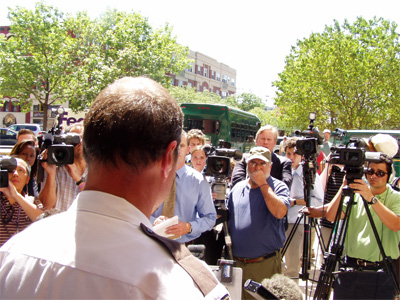
Nobody, for the most part, likes to go into a room and be the person nobody wants to see. Newspeople, as far as I know, learn to accept it and we tell ourselves it’s part of the job and a small price to pay for preserving truth and democracy and whatever other blather we come up with.
But the real truth? People in my business need to stop rationalizing traumatizing innocent people over some fictitious justification. And they need to figure out a way to do that while still being able to tell people what the heck is going on.
At the conference in Brooklyn Park on Wednesday (see several entries below), public safety and behavioral health professionals analyzed the I-35W bridge tragedy and planned for the next big disaster, considering challenges such as counseling, food, shelter, medicine, rescue equipment, organizing volunteers and cooperation among the dozens of entities that are involved in these sorts of things.
The I-35W bridge disaster brought out the best in these emergency workers of all stripes, especially given the bureaucratic nightmare of it all. “It was a federally-owned bridge, operated and maintained by the state, which fell into a river controlled by the county, and the riverbanks were owned by the city,” said conference organizer Jonathan Bundt .
But a common theme emerged among many speakers on the psychological footprint of disaster — the trauma inflicted by reporters.
Granted public safety folks and journalists have always had an adversarial relationship, and there’s usually a good reason for that. But when a bridge falls down, and families are in unimaginable pain, we — the media — shouldn’t be making it worse.
“The media has got to fill the time,” said Bundt, “but every time they’d report something, we’d get inundated by the families and 75 to 80 percent of the time, the information was inaccurate.”
Bundt said the real problem last August with the family assistance center he set up, is that it was set up at the Holiday Inn, near the bridge, a site too accessible to the public and reporters.
“All the families had to walk through the lobby to get to the room,” Bundt said, invoking an image of a gauntlet of reporters anxious to know what it feels like to think your loved one may be dead. The public has a right to know, one supposes. But doesn’t the public already know the answer to that question?
So in addition to the other challenges the behavioral health specialists faced that August night, among the biggest was the psychological trauma inflicted by reporters.
“The news people are never, ever on your side,” Rev. Jeffrey Stewart told the attendees on Wednesday, as he described racing the media to be the first to tell a woman that her husband was dead. (See post)
Leesa Dentinger, whose cousin, Christina Sacorafas died in the collapse, told the group that among the best things the family assistance center did, was “keeping the media away from us.”
A Minneapolis police official, the group was told, surreptitiously arranged a secret visit to the bridge site for family members, so that they could look over the side of the 10th Street Bridge and not worry about the media. She said he got in trouble for that.
Another person told me a reporter posed as someone who was related to a bridge victim to try to get into the area where the families were.
To be sure, not every journalist was — or is — a jerk. Bundt said many gave him their business cards, and he put them on a wall with a sign for the families that if they wanted to talk, they could take their pick. “Some people need to tell their story,” he said. It was a remarkably civilized and effective way to get a story, and perhaps it should be part of planning for the next disaster.
Behind the scenes, Bundt was dealing with the “diversity” of the families. Not just ethnic and racial, but rural people who didn’t understand the city; and families of divorce coming together in a not-always-pleasant way. “When trauma hits, you can’t hold it in,” he said, noting that often family members had to get away from other family members.
It’s a long-standing dilemma for journalists: how to cover a story and not make it worse. Before leveling the criticism on Wednesday, each person prefaced it with “the media was just doing its job, but….” And perhaps that’s the first step journalists can take to prepare for the next disaster: getting it through our heads — and yours — that making things worse isn’t part of the job.
“I hope you didn’t take my comments personally,” Rev. Stewart said to me afterwards. I did… but not for the reason he thinks.
